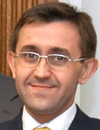Co-Located Conference AgendasFlow Chemistry Summit 2022 | Innovations in API Manufacture 2022 | 

Thursday, 17 March 202208:00 | Conference Registration, Materials Pick-Up, Morning Coffee and Pastries | |
Session Title: Conference Opening Session -- Emerging Themes in the APIs Space 2022 |
| | 09:00 |  | Conference Chair Local Drug Manufacturing in Africa Following the COVID-19 Pandemic
Paul Watts, Distinguished Professor and Research Chair, Nelson Mandela University, South Africa
While Africa has a variety of companies that formulate medicines it has very little active pharmaceutical ingredient (API) manufacturing, with the consequence that these need to be imported. This results in increased drug costs, making medications unaffordable to most patients in Africa. Economic, social and political stresses have been witnessed all over the world during the COVID-19 pandemic. In particular, drug shortages and inaccessibility is one of the many results of disruption of supply chains due to the shutdown of manufacturing activity, as well as export restrictions and bans by other countries. To this effect, we are working on developing local drug manufacturing capacity in Africa using continuous flow technology, with the goal of lowering the cost of drugs, improving drug accessibility and ultimately improving Africa’s health. A selection of examples will be presented. |
| 09:45 | Continuous-Flow C-C Coupling via Single-Atom Catalysis
Gianvito Vilé, Associate Professor in Chemical Engineering, Politecnico di Milano, Italy
Flow synthesis and single-atom catalysis are currently attracting a wide attention for sustainable chemical and pharmaceutical synthesis. In this lecture, I will demonstrate the synergistic merger of metallic single-atom catalysis and flow chemistry for the cross-coupling synthesis of pharmaceutically-relevant intermediates. Specifically, the metal and redox catalytic cycles are combined within one single-atom material which can be easily recovered and re-used in a flow reactor for several times, preserving its activity between individual trials. Finally, with the help of DFT calculations, I will elucidate the active site of the single-atom material and propose a plausible reaction mechanism for the flow reaction. | 10:30 | Continuous Flow Technologies: A Powerful Tool for the Development of Sustainable, Stereoselective Catalytic Reactions
Maurizio Benaglia, Full Professor of Organic Chemistry, Dipartimento di Chimica, Università degli Studi di Milano, Italy
The use of enabling technologies and continuous-flow systems are becoming more and more important in the synthesis of chiral APIs (active pharmaceutical ingredients). Organocatalytic reactions in (micro)-mesoreactors will be discussed, and compared with stereoselective catalytic in-flow reactions in 3D-printed reactors. The combination of organocatalysis and photochemistry can give access to molecules in one step which would otherwise be difficult to attain. Generally, the examples of asymmetric organocatalyzed photochemical reactions translated into continuous flow are rare. An efficient continuous flow photoredox reactor, that was incorporated as one unit of operation into the first fully telescoped, continuous asymmetric catalytic synthesis of a privileged API will be presented. A visible-light catalyzed cyclization of bis(enones) to afford enantiomerically enriched cyclopentane rings and a continuous flow approach to access alpha-trifluoromethylthiolated esters and amides starting from commercially available arylacetic acids will be also described. | 11:00 | Mid-Morning Coffee Break and Networking | 11:30 | Enhancing the Synthetic Utility of alpha-Diazocarbonyl Compounds Through Use of Continuous Flow Technology
Anita Maguire, Professor of Pharmaceutical Chemistry, University College Cork, Ireland
While alpha-diazocarbonyl compounds are extremely versatile intermediates in organic synthesis, their use at scale is limited by safety concerns, in particular in relation to potentially hazardous precursors such as sulfonyl azides or diazoalkanes. Recent results from the team will be presented showing that sulfonyl azides can be generated in flow and used directly in diazo transfer to form a wide range of alpha-diazocarbonyl compounds. Furthermore, the successful telescoping of these steps with subsequent enantioselective transition metal catalyzed reactions has been demonstrated. Thus, the synthetic potential of alpha-diazocarbonyl compounds can be accessed without isolating or handling either the sulfonyl azide or the alpha-diazocarbonyl compound. Five distinct protocols for diazo transfer in continuous flow have been developed, ensuring broad applicability across a range of substrates. | 12:15 | Networking Lunch | 14:00 | Development of a High Purity Continuous Flow Synthesis of Diazepam
David Thompson, Professor, Department of Chemistry, Purdue University, United States of America
We report an optimized two-step continuous flow synthesis of diazepam, an agent on the World Health Organization’s (WHO) list of essential medicines. Different conditions were rapidly screened in microfluidic chip reactors where the residence time, temperature, solvent, and ammonia sources were varied to identify the best telescoped reaction conditions. The optimal flow process uses two telescoped reactors operating at 0°C for the first step and 60°C for the second step to produce 98% pure diazepam with a total residence time of 15 minutes. | 14:45 | Exploiting Continuous Photochemistry for the Effective Generation of Drug-like Scaffolds
Marcus Baumann, Assistant Professor, School of Chemistry, University College Dublin, Ireland
This talk will showcase recent work from our group where the use of flow photochemistry enabled greener and more effective entries towards drug-like structures. Direct excitation and photocatalytic methods are explored to afford a variety of products in short time and high yield. The flow approach was additionally used for the discovery of a new cascade process as well as the verification of its mechanism by the selective generation and characterization of late-stage intermediates. | 15:30 | Mid-Afternoon Coffee Break | 16:00 | Exploitation of Formamide and Lignin For Molecular Construction
Leandro Helgueira de Andrade, Associate Professor, UNIVERSITY OF SÃO PAULO, Brazil
| 16:45 | Process Intensification for API Synthesis: A New Window of Opportunity for Underdeveloped Countries
Rodrigo de Souza, Associate Professor, Federal University of Rio De Janeiro, Brazil
Chemistry has over the decades been able to develop very complex transformations to produce multifunctional molecules. Despite these important advances, we are still using round bottom flasks and batch reactors to perform such transformations as 200 years ago. We are under a continuous-manufacturing transformation where technology will play a major role on the chemistry industry in the next years. The flow chemistry market reached $1.2 billion in 2018 and is expected to value $2.9 billions by the year of 2026, with a solid 11.3% CAGR. As the time flow synthesis can squeeze buildings for batch facilities under a portable container sized solution, the advantage using this type of production is becoming more and more evident. The inherent capacity of flow chemistry to reduce CAPEX and operational costs to a fraction, and to speed up processes and the suitability to take advantage on fully automated facilities, can lead flow chemistry towards a safer, cleaner and cheaper future than batch processing. Flow chemistry technology represents today, not only a bright future for chemical synthesis, but also represents an opportunity for underdeveloped countries to build their industrial bases and become self-sufficient regarding their needs for specialty chemicals, from basic pesticides for agriculture to complex molecules to support their basic health system, such as active pharmaceutical Ingredients (APIs). During the last years our group has focused efforts on the development of chemo and enzymatic methodologies towards the synthesis of fine chemicals, intermediates and final APIs, which are important for the chemical industry in Brazil. Several examples will be shown, some of them featuring cascade chemo-enzymatic reactions, on the synthesis of levetiracetam, ethambutol, crizotinib, donepezil, among others. | 17:15 | Commercialization of a One Step Continuous Synthesis of Flucytosine
Eugene Lottering, CEO, Msizi Pharmaceutical Holdings, South Africa
The one-step continuous flow synthesis technology for the manufacture of Flucytosine was developed and prototyped in Europe. It is being transferred to South Africa by Msizi Pharmaceutical Holdings (Pty) Ltd a start-up API manufacturing company. Flucytosine is an important anti-fungal that is unavailable in the majority of African countries. However, it is also a key intermediate in the manufacture of some Anti-retroviral APIs currently used in South Africa and on the African continent. Continuous manufacturing via flow chemistry provides South Africa with an opportunity to localize the manufacture of Essential medicine APIs. | 17:45 |  | Keynote Presentation Life Cycle Assessment of Multistep Benzoxazole Synthesis: From Batch to Waste-Minimized Continuous Flow Systems
Volker Hessel, Professor,, The University of Adelaide, Australia
This presentation focuses on the progress of synthesis methods for the preparation of 2-aryl benzoxazoles as highly interesting materials with increasing relevance in the pharmaceutical industry (as well as in optical applications). The traditional production methods of 2-aryl benzoxazoles clearly have some drawbacks related to the use of strong acids and/or toxic reagents leading to a large production of waste. Importantly, a comprehensive analysis of the associated risk in terms of safety, environmental impact and disposal cost is lacking. In this regard, the life cycle assessment (LCA) methodology is herein applied to ultimately evaluate the environmental profile of the available routes to access 2-aryl benzoxazoles. Seven batch synthesis approaches and two continuous-flow (CF) approaches (small and large scale) are closely compared. The superiority of the CF technology is ultimately proven among the analysed environmental impact categories. The main finding is that the oxygen-flow chemistry intensification fortified the sustainability of the green chemistry principles (towards the catalyst/solvent) themselves by ensuring the regeneration of OMS catalysts and reduction of manganese leaching to the minimum by the CPME solvent, which also provided high solvent recyclability. In this way, it adds circularity in the sense of its 10R framework (e.g. R standing for recycle, repair, rethink, and refuse). As a result, for example, our flow approach reduces carbon emissions by 85% in comparison with our batch approach, the latter exhibiting lower environmental impact than the six batch approaches from the literature. In addition, our flow chemistry process has lower energy consumption and solvent load, whose share is up to 88% of the environmental impact. |
| 18:30 | Close of Programming on Day 1 of the Conference |
Friday, 18 March 2022 |
Please Refer to the Flow Chemistry Summit Agenda for Programming Details of Day 2 (Friday, March 18, 2022) |
| |
|


 Add to Calendar ▼2022-03-17 00:00:002022-03-18 00:00:00Europe/LondonInnovations in API Manufacture 2022Innovations in API Manufacture 2022 in BostonBostonSELECTBIOenquiries@selectbiosciences.com
Add to Calendar ▼2022-03-17 00:00:002022-03-18 00:00:00Europe/LondonInnovations in API Manufacture 2022Innovations in API Manufacture 2022 in BostonBostonSELECTBIOenquiries@selectbiosciences.com